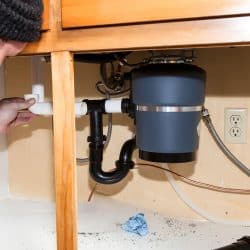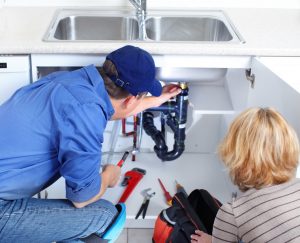Clear Instructions for Repairing a Leaky Waste Disposal
Clear Instructions for Repairing a Leaky Waste Disposal
Blog Article
Here in the next paragraph you'll find more high-quality insight involving Garbage Disposal Leaking From Bottom.

Garbage disposals are vital cooking area appliances that help in disposing of food waste successfully. Nevertheless, a leaking garbage disposal can be a frustrating and messy trouble to manage. The good news is, numerous leaks can be fixed conveniently with a couple of easy actions. In this post, we will talk about exactly how to repair a dripping waste disposal unit successfully.
Introduction
Garbage disposals are installed under kitchen area sinks and are created to shred food waste right into smaller sized pieces, allowing it to pass through the plumbing system conveniently. While these devices are generally trustworthy, leaks can happen over time because of damage, loosened connections, or damages to the system.
Typical Causes of Leakages in Rubbish Disposals
Worn Seals and Gaskets
Seals and gaskets play an essential role in preventing water from leaking out of the garbage disposal. With time, these elements can weaken, resulting in leakages around the disposal device.
Loose Connections
The links between the garbage disposal and the plumbing system can come to be loosened over time, triggering water to leakage out throughout operation.
Cracks or Openings in the Disposal System
Physical damage to the waste disposal unit, such as fractures or holes in the real estate, can likewise cause leakages.
Determining the Source of the Leakage
Before trying to repair a leaking waste disposal unit, it is important to identify the resource of the leak. This can generally be done through aesthetic assessment or by conducting straightforward tests.
Visual Evaluation
Examine the waste disposal unit system thoroughly for any type of indicators of water leak. Pay attention to locations around seals, gaskets, and link points.
Testing for Leakages
One means to check for leaks is by running water through the disposal system and looking for any kind of visible indications of leakage.
Tools and Products Needed for Dealing With a Leaking Garbage Disposal
Prior to starting the repair service process, gather the necessary devices and products, consisting of a screwdriver, adjustable wrench, plumbing's putty, replacement seals or gaskets, and epoxy or patching material for fixing splits or holes.
Step-by-Step Overview to Repairing a Dripping Waste Disposal Unit
Turn Off the Power
Before attempting any type of repairs, make sure that the power to the waste disposal unit device is shut off to prevent the risk of electrical shock.
Situate the Leakage
Determine the precise location of the leakage and figure out the cause.
Tighten up Connections
Make use of a wrench to tighten up any kind of loose links in between the disposal unit and the pipes system.
Replace Seals or Gaskets
If the leakage is due to used seals or gaskets, remove the old parts and change them with new ones.
Patching Fractures or Openings
For cracks or openings in the disposal device, usage epoxy or an appropriate patching product to seal the damaged area.
Evaluating the Waste Disposal Unit After Repair Work
Once the repair service is complete, examine the waste disposal unit by running water through it to guarantee that the leakage has actually been dealt with.
Preventive Upkeep Tips to Prevent Future Leaks
To avoid future leaks, it is vital to perform routine maintenance on your waste disposal unit. This includes keeping it clean, staying clear of putting non-food things or hard items down the disposal, and periodically looking for leakages or various other issues.
Verdict
In conclusion, dealing with a leaking waste disposal unit is a reasonably straightforward process that can be finished with fundamental devices and products. By adhering to the steps detailed in this write-up and exercising preventative upkeep, you can maintain your garbage disposal in good working condition and prevent costly repair work in the future.
HERE’S HOW TO FIX YOUR GARBAGE DISPOSAL
WHAT TO DO IF SOMETHING IS STUCK IN YOUR GARBAGE DISPOSAL
If the impeller won’t turn, there’s probably something stuck in the disposal. It could be a steak bone or peach pit, although plumbers report pulling all sorts of inappropriate objects out of disposals, such as bottle caps or aluminum foil. Make sure power to the disposal is off, and look inside to see if you can see the source of the jam.
Never stick your fingers in a disposal. Pull out anything you see with tongs or pliers.
If the disposal still won’t work, it may be time to call a plumber or consider buying a new disposal. GEM Plumbing & Heating is here for all of your garbage disposal needs.
WHAT TO DO IF YOUR GARBAGE DISPOSAL DRAIN IS CLOGGED
Take everything out from underneath your sink and put a bucket or other container under your disposal to catch any water that drains out. Disconnect your disposal from the power supply. If it’s plugged into a wall outlet, unplug it. If it’s hardwired into an electrical box, go to the electrical panel and turn off the breaker for the disposal. Pour ¼ cup of baking soda into the drain, followed by ½ cup of white vinegar. Give the solution a few minutes to fizz and do its work. Look into the disposal with a flashlight to see if you can see an object that might be causing the clog. If you see it, remove it using tongs or pliers. MORE TIPS ON DEALING WITH A CLOGGED GARBAGE DISPOSAL
Never use drain cleaner in a garbage disposal. It can damage the plastic parts inside the disposal. You can also be splashed with the caustic liquid while working to clear the clog. Beware! Never stick your fingers into a garbage disposal. Trust us — not a good idea. In many instances, your dishwasher drains through your garbage disposal. This allows the disposal to grind any large food particles that may be drained out of your dishwasher. There are some jurisdictions, however, where the plumbing code prohibits such a connection. WHAT TO DO WHEN YOUR DISHWASHER DRAINS THROUGH THE DISPOSAL
Run some water in the sink so your plunger has at least a ½-inch of water to create a seal and plunge vigorously up and down several times. You may need to repeat this several times. Run hot water down the drain to clear any residue that remains.

I recently found that content on Garbage Disposal Leaking From Bottom when doing a search on the web. I beg you set aside a second to promote this blog entry if you appreciated it. Thank-you for going through it.
Book Services Report this page